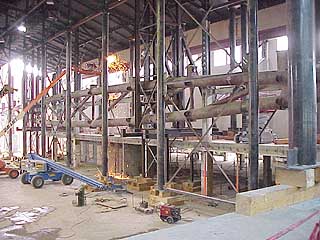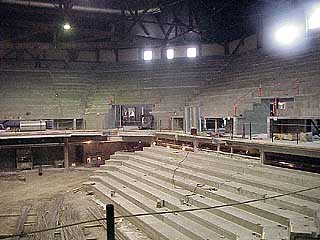|
Subscribe / Renew |
|
|
Contact Us |
|
| ► Subscribe to our Free Weekly Newsletter | |
| home | Welcome, sign in or click here to subscribe. | login |
Construction
| |
 |
November 2, 2000
UW's Hec Ed is ready for another 75-year run
SWMB
Hec Edmundson Pavilion has been a part of Husky athletics for three-quarters of a century, and with the current renovation, it will be ready to go for another 75 years. The renovated Pavilion will be full of new amenities for fans, athletes and coaching staff. The most noticeable improvement will be the removal of 22 view-obstructing columns that have long been a complaint for fans attending events at Hec Edmundson.

|
In the early 1990s, the University’s Athletic Department realized a need to improve its athletic facilities. Hec Edmundson Pavilion, used by student athletes for intercollegiate events, practices, locker rooms and training rehabilitation, was defined as a priority for modernization. A seismic assessment of the 1927 building highlighted a number of deficiencies by current life safety seismic standards. Many of the materials and construction practices used during the era Hec Edmundson was built have, when not upgraded, led to poor performance during significant seismic ground motions.
Setting goals
The results of the seismic assessment and the desire to recreate Hec Edmundson as a multi-use facility that would attract fans and student athletes drove the modernization project. Along with the seismic upgrade, additional goals were defined to help recreate the building. These goals included:
- Provide a new fully enclosed seating bowl to bring fans closer to the court
- Add a new Husky Hall of Fame and Husky Founder’s Club facility for fan use
- Provide modern practice and locker facilities for varsity teams
In addition to these goals, the University also requested that the exterior of the building remain intact to preserve the rich history and tradition of the building’s first 75 years.
The game plan
In the development of the seating bowl, it was apparent that many of the original interior columns would interfere with the new layout and must be removed. The interfering columns supported the existing roof trusses that spanned over the court and seating area. Since the University had recently re-roofed the Pavilion, they did not want to remove and replace any of the existing roof system. This required the examination of a number of alternatives to find a structural solution.
One option for removing the columns was to extend the 11 existing roof trusses beyond the offending columns so that they spanned to the exterior walls of the pavilion. An analysis showed that most truss members and joint connections would require modification for the new spans. This option was found to be costly and a significant impact to the construction schedule.
Another option was to replace the lines of supporting columns with large trusses cross-spanning the length of the new seating bowl, thus allowing unobstructed viewing. A number of truss concepts were considered. A driving obstacle in the development of the new truss configuration was that the truss could only be about half as deep as a conventional steel truss for the required 240-foot span to avoid affecting sight-lines in the upper portions of the seating bowl.
Ultimately, a truss concept was selected that took advantage of materials not commonly used in long-span design. The concept developed by Skilling, working for LMN Architects and with Sellen CM, uses a high-strength concrete-filled-pipe top chord element and a bottom pipe chord filled with 132 high-strength post-tensioning cables. This composite concept, which still had steel pipe bracing and vert members, was found to be significantly less expensive than a truss made entirely from steel members. The composite truss system was also a better solution for both cost and scheduling reasons.
Executing the play
The construction of the truss was a significant feat in itself. With the new trusses being located where existing columns still stood, a detailed shoring and erection schedule had to be developed. The schedule first had temporary shoring poles located adjacent to the existing columns to temporarily support the existing roof trusses. Then, the existing columns were cut away to make room for the new trusses. The new trusses were fabricated on the floor of the pavilion, then raised and slid into position using specially designed erection towers.
Once the trusses were in their final positions, the top pipe chord was filled with high-strength concrete. After allowing time for the concrete to cure, a two-phase post tensioning sequence was used to transfer the roof loading from the existing the trusses onto the new trusses. Once the second phase of the post tensioning was complete, the new trusses were self-supporting, allowing removal of the temporary shoring system. Even though removal of the columns created a very long span for the roof, at no time did the roof move vertically more than 3/8ths of an inch.
A full-court strategy
Another significant structural contribution was the upgrade design for the pavilion so that it would meet current standards for life safety following a seismic event. The upgrade involved the addition of a number of new steel-braced frames and concrete shearwalls that support not only the new interior construction but also the remaining exterior shell of the building.

Photos courtsey of Sellen Construction |
A seismic review of the existing roof system found it to fall below earthquake standards. To address this issue, a new horizontal steel-truss system was introduced at the roof level to laterally reinforce the roof and transmit the expected loading to the new braced frames. Finally, another life safety improvement was the reinforcement of the wall systems constructed in 1927 with a steel-wire mesh, which will capture any brittle pieces of wall that might loosen during a seismic event.
The tournament championship
When Hec Edmundson Pavilion opens to Husky fans and athletes later this month, the significant changes accomplished will be visually apparent to all. There will be new seating, new lounges, and new locker rooms. However, because of the foresight and direction of the University, the tradition found in the Pavilion will remain the same.
Ken Dahl, P.E., is a senior associate with Skilling Ward Magnusson Barkshire Inc.
Other Stories:
- Robots help with demolition
- Who the heck is Hec?
- Rehabbed arena is designed for the future while still respecting the past
- Universities spend big to earn more


